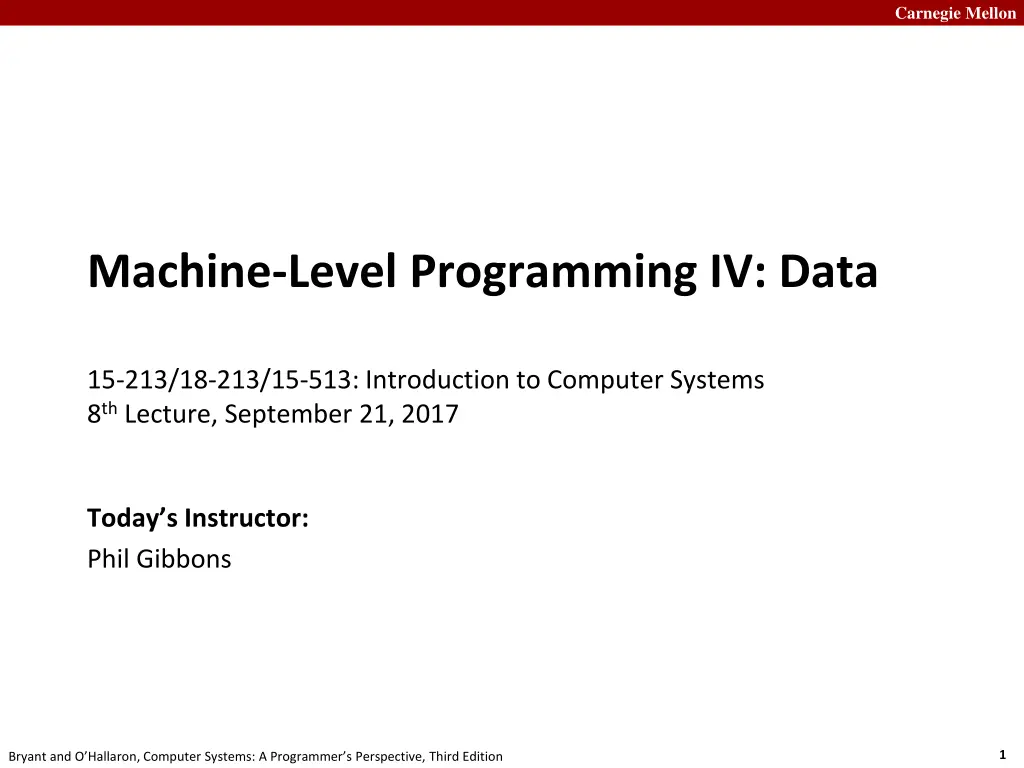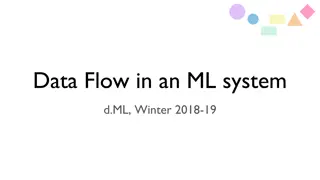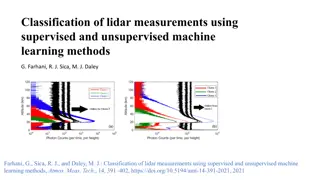
Carnegie Mellon Machine-Level Programming IV: Data Structures and Array Access Principles
Explore the fundamentals of array allocation, access principles, and examples in machine-level programming as taught at Carnegie Mellon University. Dive into topics such as one-dimensional and multi-dimensional arrays, nested structures, allocation, access, data alignment, and more. Gain insights from the lecture by instructor Phil Gibbons and the textbook "Computer Systems: A Programmer's Perspective" by Bryant and O'Hallaron.
Download Presentation

Please find below an Image/Link to download the presentation.
The content on the website is provided AS IS for your information and personal use only. It may not be sold, licensed, or shared on other websites without obtaining consent from the author. If you encounter any issues during the download, it is possible that the publisher has removed the file from their server.
You are allowed to download the files provided on this website for personal or commercial use, subject to the condition that they are used lawfully. All files are the property of their respective owners.
The content on the website is provided AS IS for your information and personal use only. It may not be sold, licensed, or shared on other websites without obtaining consent from the author.
E N D
Presentation Transcript
Carnegie Mellon Machine-Level Programming IV: Data 15-213/18-213/15-513: Introduction to Computer Systems 8thLecture, September 21, 2017 Today s Instructor: Phil Gibbons 1 Bryant and O Hallaron, Computer Systems: A Programmer s Perspective, Third Edition
Carnegie Mellon Today Arrays One-dimensional Multi-dimensional (nested) Multi-level Structures Allocation Access Alignment Floating Point 2 Bryant and O Hallaron, Computer Systems: A Programmer s Perspective, Third Edition
Carnegie Mellon Array Allocation Basic Principle T A[L]; Array of data type T and length L Contiguously allocated region of L * sizeof(T) bytes in memory char string[12]; x x + 12 int val[5]; x x + 4 x + 8 x + 12 x + 16 x + 20 double a[3]; x x + 8 x + 16 x + 24 char *p[3]; x x + 8 x + 16 x + 24 3 Bryant and O Hallaron, Computer Systems: A Programmer s Perspective, Third Edition
Carnegie Mellon Array Access Basic Principle TA[L]; Array of data type T and length L Identifier A can be used as a pointer to array element 0: Type T* 1 5 2 1 3 int val[5]; x + 16 x + 20 x x + 4 x + 8 x + 12 Reference val[4] val val+1 &val[2] val[5] *(val+1) val + i Type int int * int * int * int int int * Value 3 4 Bryant and O Hallaron, Computer Systems: A Programmer s Perspective, Third Edition
Carnegie Mellon Array Access Basic Principle TA[L]; Array of data type T and length L Identifier A can be used as a pointer to array element 0: Type T* 1 5 2 1 3 int val[5]; x + 16 x + 20 x x + 4 x + 8 x + 12 Reference val[4] val val+1 &val[2] val[5] *(val+1) val + i Type int int * int * int * int int int * Value 3 x x + 4 x + 8 ?? 5 //val[1] x + 4 * i //&val[i] 5 Bryant and O Hallaron, Computer Systems: A Programmer s Perspective, Third Edition
Carnegie Mellon Array Example #define ZLEN 5 typedef int zip_dig[ZLEN]; zip_dig cmu = { 1, 5, 2, 1, 3 }; zip_dig mit = { 0, 2, 1, 3, 9 }; zip_dig ucb = { 9, 4, 7, 2, 0 }; zip_dig cmu; 1 5 2 1 3 16 20 24 28 32 36 zip_dig mit; 0 2 1 3 9 36 40 44 48 52 56 zip_dig ucb; 9 4 7 2 0 56 60 64 68 72 76 Declaration zip_dig cmu equivalent to int cmu[5] Example arrays were allocated in successive 20 byte blocks Not guaranteed to happen in general 6 Bryant and O Hallaron, Computer Systems: A Programmer s Perspective, Third Edition
Carnegie Mellon Array Accessing Example zip_dig cmu; 1 5 2 1 3 16 20 24 28 32 36 int get_digit (zip_dig z, int digit) { return z[digit]; } Register %rdi contains starting address of array Register %rsi contains array index x86-64 # %rdi = z # %rsi = digit movl (%rdi,%rsi,4), %eax # z[digit] Desired digit at %rdi + 4*%rsi Use memory reference (%rdi,%rsi,4) 7 Bryant and O Hallaron, Computer Systems: A Programmer s Perspective, Third Edition
Carnegie Mellon Array Loop Example void zincr(zip_dig z) { size_t i; for (i = 0; i < ZLEN; i++) z[i]++; } # %rdi = z movl jmp .L4: # loop: addl $1, (%rdi,%rax,4) # z[i]++ addq $1, %rax .L3: # middle cmpq $4, %rax jbe .L4 # if <=, goto loop rep; ret $0, %eax .L3 # goto middle # i = 0 # i++ # i:4 9 Bryant and O Hallaron, Computer Systems: A Programmer s Perspective, Third Edition
Carnegie Mellon Understanding Pointers & Arrays #1 A1 , A2 *A1 , *A2 Decl Comp Bad Size Comp Bad Size int A1[3] int *A2 Comp: Compiles (Y/N) Bad: Possible bad pointer reference (Y/N) Size: Value returned by sizeof 10 Bryant and O Hallaron, Computer Systems: A Programmer s Perspective, Third Edition
Carnegie Mellon Understanding Pointers & Arrays #1 A1 , A2 *A1 , *A2 Decl Comp Bad Size Comp Bad Size Y N 12 Y N 4 int A1[3] Y N 8 Y Y 4 int *A2 A1 Allocated pointer Unallocated pointer A2 Allocated int Unallocated int Comp: Compiles (Y/N) Bad: Possible bad pointer reference (Y/N) Size: Value returned by sizeof 11 Bryant and O Hallaron, Computer Systems: A Programmer s Perspective, Third Edition
Carnegie Mellon Understanding Pointers & Arrays #2 An *An **An Decl Cmp Bad Size Cmp Bad Size Cmp Bad Size int A1[3] int *A2[3] int (*A3)[3] A1 A2 A3 Allocated pointer Unallocated pointer Allocated int Unallocated int 12 Bryant and O Hallaron, Computer Systems: A Programmer s Perspective, Third Edition
Carnegie Mellon Understanding Pointers & Arrays #2 An *An **An Decl Cmp Y Bad N Size 12 Cmp Y Bad N Size 4 Cmp N Bad - Size - int A1[3] Y N 24 Y N 8 Y Y 4 int *A2[3] Y N 8 Y Y 12 Y Y 4 int (*A3)[3] A1 A2 A3 Allocated pointer Unallocated pointer Allocated int Unallocated int 13 Bryant and O Hallaron, Computer Systems: A Programmer s Perspective, Third Edition
Carnegie Mellon Multidimensional (Nested) Arrays Declaration TA[R][C]; 2D array of data type T R rows, C columns A[0][0] A[0][C-1] Array Size R * C * sizeof(T)bytes A[R-1][0] A[R-1][C-1] Arrangement Row-Major Ordering int A[R][C]; A A A A A A [0] [0] [0] [C-1] [1] [0] [1] [C-1] [R-1] [0] [R-1] [C-1] 4*R*C Bytes 14 Bryant and O Hallaron, Computer Systems: A Programmer s Perspective, Third Edition
Carnegie Mellon Nested Array Example #define PCOUNT 4 typedef int zip_dig[5]; zip_dig pgh[PCOUNT] = {{1, 5, 2, 0, 6}, {1, 5, 2, 1, 3 }, {1, 5, 2, 1, 7 }, {1, 5, 2, 2, 1 }}; zip_dig pgh[4]; 1 5 2 0 6 1 5 2 1 3 1 5 2 1 7 1 5 2 2 1 76 96 116 136 156 zip_dig pgh[4] equivalent to int pgh[4][5] Variable pgh: array of 4 elements, allocated contiguously Each element is an array of 5 int s, allocated contiguously Row-Major ordering of all elements in memory 15 Bryant and O Hallaron, Computer Systems: A Programmer s Perspective, Third Edition
Carnegie Mellon Nested Array Row Access Row Vectors A[i] is array of C elements of type T Starting address A + i * (C * sizeof(T)) int A[R][C]; A[0] A[i] A[R-1] A A A A A A [0] [0] [0] [C-1] [i] [0] [i] [C-1] [R-1] [0] [R-1] [C-1] A+(i*C*4) A+((R-1)*C*4) A 16 Bryant and O Hallaron, Computer Systems: A Programmer s Perspective, Third Edition
Carnegie Mellon Nested Array Row Access Code 1 5 2 0 6 1 5 2 1 3 1 5 2 1 7 1 5 2 2 1 int *get_pgh_zip(int index) { return pgh[index]; } pgh pgh[2] # %rdi = index leaq (%rdi,%rdi,4),%rax # 5 * index leaq pgh(,%rax,4),%rax # pgh + (20 * index) Row Vector pgh[index]is array of 5 int s Starting address pgh+20*index Machine Code Computes and returns address Compute as pgh + 4*(index+4*index) 17 Bryant and O Hallaron, Computer Systems: A Programmer s Perspective, Third Edition
Carnegie Mellon Nested Array Element Access Array Elements A[i][j]is element of type T, which requires K bytes Address A +i * (C * K) + j * K = A + (i * C + j) * K int A[R][C]; A[0] A[i] A[R-1] A A A A A [0] [0] [0] [C-1] [i] [j] [R-1] [0] [R-1] [C-1] A A+(i*C*4) A+((R-1)*C*4) A+(i*C*4)+(j*4) 18 Bryant and O Hallaron, Computer Systems: A Programmer s Perspective, Third Edition
Carnegie Mellon Nested Array Element Access Code 1 5 2 0 6 1 5 2 1 3 1 5 2 1 7 1 5 2 2 1 pgh pgh[1][1] int get_pgh_digit(int index, int dig) { return pgh[index][dig]; } leaq (%rdi,%rdi,4), %rax addl %rax, %rsi movl pgh(,%rsi,4), %eax # 5*index # 5*index+dig # M[pgh + 4*(5*index+dig)] Array Elements pgh[index][dig]isint Address: pgh + 20*index + 4*dig = pgh + 4*(5*index + dig) 19 Bryant and O Hallaron, Computer Systems: A Programmer s Perspective, Third Edition
Carnegie Mellon Multi-Level Array Example Variable univ denotes array of 3 elements zip_dig cmu = { 1, 5, 2, 1, 3 }; zip_dig mit = { 0, 2, 1, 3, 9 }; zip_dig ucb = { 9, 4, 7, 2, 0 }; Each element is a pointer 8 bytes #define UCOUNT 3 int *univ[UCOUNT] = {mit, cmu, ucb}; Each pointer points to array of int s cmu 1 5 2 1 3 univ 16 20 24 28 32 36 mit 36 160 0 2 1 3 9 16 168 176 36 40 44 48 52 56 ucb 56 9 4 7 2 0 56 60 64 68 72 76 20 Bryant and O Hallaron, Computer Systems: A Programmer s Perspective, Third Edition
Carnegie Mellon Element Access in Multi-Level Array int get_univ_digit (size_t index, size_t digit) { return univ[index][digit]; } salq $2, %rsi # 4*digit addq univ(,%rdi,8), %rsi # p = univ[index] + 4*digit movl (%rsi), %eax # return *p ret Computation Element access Mem[Mem[univ+8*index]+4*digit] Must do two memory reads First get pointer to row array Then access element within array 21 Bryant and O Hallaron, Computer Systems: A Programmer s Perspective, Third Edition
Carnegie Mellon Array Element Accesses Multi-level array Nested array int get_pgh_digit (size_t index, size_t digit) { return pgh[index][digit]; } int get_univ_digit (size_t index, size_t digit) { return univ[index][digit]; } Accesses looks similar in C, but address computations very different: Mem[Mem[univ+8*index]+4*digit] Mem[pgh+20*index+4*digit] 22 Bryant and O Hallaron, Computer Systems: A Programmer s Perspective, Third Edition
Carnegie Mellon N X N Matrix Code #define N 16 typedef int fix_matrix[N][N]; /* Get element A[i][j] */ int fix_ele(fix_matrix A, size_t i, size_t j) { return A[i][j]; } Fixed dimensions Know value of N at compile time #define IDX(n, i, j) ((i)*(n)+(j)) /* Get element A[i][j] */ int vec_ele(size_t n, int *A, size_t i, size_t j) { return A[IDX(n,i,j)]; } Variable dimensions, explicit indexing Traditional way to implement dynamic arrays /* Get element a[i][j] */ int var_ele(size_t n, int A[n][n], size_t i, size_t j) { return A[i][j]; } Variable dimensions, implicit indexing Now supported by gcc 23 Bryant and O Hallaron, Computer Systems: A Programmer s Perspective, Third Edition
Carnegie Mellon 16 X 16 Matrix Access Array Elements int A[16][16]; Address A +i * (C * K) + j * K C = 16, K = 4 /* Get element A[i][j] */ int fix_ele(fix_matrix A, size_t i, size_t j) { return A[i][j]; } # A in %rdi, i in %rsi, j in %rdx salq $6, %rsi # 64*i addq %rsi, %rdi # A + 64*i movl (%rdi,%rdx,4), %eax # M[A + 64*i + 4*j] ret 24 Bryant and O Hallaron, Computer Systems: A Programmer s Perspective, Third Edition
Carnegie Mellon n X n Matrix Access Array Elements size_t n; int A[n][n]; Address A + i * (C * K) + j * K C = n, K = 4 Must perform integer multiplication /* Get element A[i][j] */ int var_ele(size_t n, int A[n][n], size_t i, size_t j) { return A[i][j]; } # n in %rdi, A in %rsi, i in %rdx, j in %rcx imulq %rdx, %rdi # n*i leaq (%rsi,%rdi,4), %rax # A + 4*n*i movl (%rax,%rcx,4), %eax # A + 4*n*i + 4*j ret 25 Bryant and O Hallaron, Computer Systems: A Programmer s Perspective, Third Edition
Carnegie Mellon Example: Array Access #include <stdio.h> #define ZLEN 5 #define PCOUNT 4 typedef int zip_dig[ZLEN]; int main(int argc, char** argv) { zip_dig pgh[PCOUNT] = {{1, 5, 2, 0, 6}, {1, 5, 2, 1, 3 }, {1, 5, 2, 1, 7 }, {1, 5, 2, 2, 1 }}; int *linear_zip = (int *) pgh; int *zip2 = (int *) pgh[2]; int result = pgh[0][0] + linear_zip[7] + *(linear_zip + 8) + zip2[1]; printf("result: %d\n", result); return 0; } linux> ./array result: 9 26 Bryant and O Hallaron, Computer Systems: A Programmer s Perspective, Third Edition
Carnegie Mellon Example: Array Access #include <stdio.h> #define ZLEN 5 #define PCOUNT 4 typedef int zip_dig[ZLEN]; int main(int argc, char** argv) { zip_dig pgh[PCOUNT] = {{1, 5, 2, 0, 6}, {1, 5, 2, 1, 3 }, {1, 5, 2, 1, 7 }, {1, 5, 2, 2, 1 }}; int *linear_zip = (int *) pgh; int *zip2 = (int *) pgh[2]; int result = pgh[0][0] + linear_zip[7] + *(linear_zip + 8) + zip2[1]; printf("result: %d\n", result); return 0; } linux> ./array result: 9 27 Bryant and O Hallaron, Computer Systems: A Programmer s Perspective, Third Edition
Carnegie Mellon Quiz Time! Check out: https://canvas.cmu.edu/courses/1221 28 Bryant and O Hallaron, Computer Systems: A Programmer s Perspective, Third Edition
Carnegie Mellon Today Arrays One-dimensional Multi-dimensional (nested) Multi-level Structures Allocation Access Alignment Floating Point 29 Bryant and O Hallaron, Computer Systems: A Programmer s Perspective, Third Edition
Carnegie Mellon Structure Representation r struct rec { int a[4]; size_t i; struct rec *next; }; a 0 i next 24 32 16 Structure represented as block of memory Big enough to hold all of the fields Fields ordered according to declaration Even if another ordering could yield a more compact representation Compiler determines overall size + positions of fields Machine-level program has no understanding of the structures in the source code 30 Bryant and O Hallaron, Computer Systems: A Programmer s Perspective, Third Edition
Carnegie Mellon Generating Pointer to Structure Member r r+4*idx struct rec { int a[4]; size_t i; struct rec *next; }; a 0 i next 24 32 16 int *get_ap (struct rec *r, size_t idx) { return &r->a[idx]; } Generating Pointer to Array Element Offset of each structure member determined at compile time Compute as r + 4*idx # r in %rdi, idx in %rsi leaq (%rdi,%rsi,4), %rax ret 31 Bryant and O Hallaron, Computer Systems: A Programmer s Perspective, Third Edition
Carnegie Mellon struct rec { int a[4]; int i; struct rec *next; }; Following Linked List C Code r void set_val (struct rec *r, int val) { while (r) { int i = r->i; r->a[i] = val; r = r->next; } } a i next 24 32 16 0 Element i Register %rdi %rsi Value r val .L11: # loop: movslq 16(%rdi), %rax movl %esi, (%rdi,%rax,4) # M[r+4*i] = val movq 24(%rdi), %rdi # r = M[r+24] testq %rdi, %rdi # Test r jne .L11 # if !=0 goto loop # i = M[r+16] 32 Bryant and O Hallaron, Computer Systems: A Programmer s Perspective, Third Edition
Carnegie Mellon Structures & Alignment Unaligned Data struct S1 { char c; int i[2]; double v; } *p; c i[0] i[1] v p p+1 p+5 p+9 p+17 Aligned Data Primitive data type requires K bytes Address must be multiple of K c i[0] i[1] v 3 bytes 3 bytes 4 bytes 4 bytes p+0 p+4 p+8 p+16 p+24 Multiple of 4 Multiple of 8 Multiple of 8 Multiple of 8 33 Bryant and O Hallaron, Computer Systems: A Programmer s Perspective, Third Edition
Carnegie Mellon Alignment Principles Aligned Data Primitive data type requires K bytes Address must be multiple of K Required on some machines; advised on x86-64 Motivation for Aligning Data Memory accessed by (aligned) chunks of 4 or 8 bytes (system dependent) Inefficient to load or store datum that spans cache lines (64 bytes). Intel states should avoid crossing 16 byte boundaries. Virtual memory trickier when datum spans 2 pages (4 KB pages) Compiler Inserts gaps in structure to ensure correct alignment of fields 34 Bryant and O Hallaron, Computer Systems: A Programmer s Perspective, Third Edition
Carnegie Mellon Specific Cases of Alignment (x86-64) 1 byte: char, no restrictions on address 2 bytes: short, lowest 1 bit of address must be 02 4 bytes: int, float, lowest 2 bits of address must be 002 8 bytes: double, long,char *, lowest 3 bits of address must be 0002 35 Bryant and O Hallaron, Computer Systems: A Programmer s Perspective, Third Edition
Carnegie Mellon Satisfying Alignment with Structures Within structure: Must satisfy each element s alignment requirement struct S1 { char c; int i[2]; double v; } *p; Overall structure placement Each structure has alignment requirement K K = Largest alignment of any element Initial address & structure length must be multiples of K Example: K = 8, due to double element c i[0] i[1] v 3 bytes 3 bytes 4 bytes 4 bytes p+0 p+4 p+8 p+16 p+24 Multiple of 4 Multiple of 8 Multiple of 8 Multiple of 8 36 Bryant and O Hallaron, Computer Systems: A Programmer s Perspective, Third Edition
Carnegie Mellon Meeting Overall Alignment Requirement For largest alignment requirement K struct S2 { double v; int i[2]; char c; } *p; Overall structure must be multiple of K v i[0] i[1] c 7 bytes p+0 p+8 p+16 p+24 Multiple of K=8 37 Bryant and O Hallaron, Computer Systems: A Programmer s Perspective, Third Edition
Carnegie Mellon Arrays of Structures struct S2 { double v; int i[2]; char c; } a[10]; Overall structure length multiple of K Satisfy alignment requirement for every element a[0] a[1] a[2] a+0 a+24 a+48 a+72 v i[0] i[1] c 7 bytes a+24 a+32 a+40 a+48 38 Bryant and O Hallaron, Computer Systems: A Programmer s Perspective, Third Edition
Carnegie Mellon Accessing Array Elements struct S3 { short i; float v; short j; } a[10]; Compute array offset 12*idx sizeof(S3), including alignment spacers Element j is at offset 8 within structure Assembler gives offset a+8 Resolved during linking a[0] a[idx] a+0 a+12 a+12*idx i v j 2 bytes 2 bytes a+12*idx a+12*idx+8 short get_j(int idx) { return a[idx].j; } # %rdi = idx leaq (%rdi,%rdi,2),%rax # 3*idx movzwl a+8(,%rax,4),%eax 39 Bryant and O Hallaron, Computer Systems: A Programmer s Perspective, Third Edition
Carnegie Mellon Saving Space Put large data types first struct S5 { int i; char c; char d; } *p; struct S4 { char c; int i; char d; } *p; c i d 3 bytes 3 bytes 3 bytes 3 bytes Effect (largest alignment requirement K=4) i c d 2 bytes 2 bytes 40 Bryant and O Hallaron, Computer Systems: A Programmer s Perspective, Third Edition
Carnegie Mellon Example Struct Exam Question http://www.cs.cmu.edu/~213/oldexams/exam1-f12.pdf 41 Bryant and O Hallaron, Computer Systems: A Programmer s Perspective, Third Edition
Carnegie Mellon Example Struct Exam Question a X X X X X X X b b b b b b b b c c c c d d d X e e e e e e e e f f f f f f f f http://www.cs.cmu.edu/~213/oldexams/exam1-f12.pdf 42 Bryant and O Hallaron, Computer Systems: A Programmer s Perspective, Third Edition
Carnegie Mellon Example Struct Exam Question (Cont d) http://www.cs.cmu.edu/~213/oldexams/exam1-f12.pdf 43 Bryant and O Hallaron, Computer Systems: A Programmer s Perspective, Third Edition
Carnegie Mellon Example Struct Exam Question (Cont d) a d d d c c c c b b b b b b b b e e e e e e e e f f f f f f f f http://www.cs.cmu.edu/~213/oldexams/exam1-f12.pdf 44 Bryant and O Hallaron, Computer Systems: A Programmer s Perspective, Third Edition
Carnegie Mellon Today Arrays One-dimensional Multi-dimensional (nested) Multi-level Structures Allocation Access Alignment Floating Point 45 Bryant and O Hallaron, Computer Systems: A Programmer s Perspective, Third Edition
Carnegie Mellon Background History x87 FP Legacy, very ugly SSE FP Supported by Shark machines Special case use of vector instructions AVX FP Newest version Similar to SSE (but registers are 32 bytes instead of 16) Documented in book 46 Bryant and O Hallaron, Computer Systems: A Programmer s Perspective, Third Edition
Carnegie Mellon Programming with SSE3 XMM Registers 16 total, each 16 bytes 16 single-byte integers 8 16-bit integers 4 32-bit integers 4 single-precision floats 2 double-precision floats 1 single-precision float 1 double-precision float 47 Bryant and O Hallaron, Computer Systems: A Programmer s Perspective, Third Edition
Carnegie Mellon Scalar & SIMD Operations Scalar Operations: Single Precision addss %xmm0,%xmm1 %xmm0 + %xmm1 SIMD Operations: Single Precision addps %xmm0,%xmm1 %xmm0 + + + + %xmm1 addsd %xmm0,%xmm1 Scalar Operations: Double Precision %xmm0 + %xmm1 48 Bryant and O Hallaron, Computer Systems: A Programmer s Perspective, Third Edition
Carnegie Mellon FP Basics Arguments passed in %xmm0, %xmm1, ... Result returned in %xmm0 All XMM registers caller-saved double dadd(double x, double y) { return x + y; } float fadd(float x, float y) { return x + y; } # x in %xmm0, y in %xmm1 addss %xmm1, %xmm0 ret # x in %xmm0, y in %xmm1 addsd %xmm1, %xmm0 ret 49 Bryant and O Hallaron, Computer Systems: A Programmer s Perspective, Third Edition
Carnegie Mellon FP Memory Referencing Integer (and pointer) arguments passed in regular registers FP values passed in XMM registers Different mov instructions to move between XMM registers, and between memory and XMM registers double dincr(double *p, double v) { double x = *p; *p = x + v; return x; } # p in %rdi, v in %xmm0 movapd %xmm0, %xmm1 # Copy v movsd (%rdi), %xmm0 # x = *p addsd %xmm0, %xmm1 # t = x + v movsd %xmm1, (%rdi) # *p = t ret 50 Bryant and O Hallaron, Computer Systems: A Programmer s Perspective, Third Edition
Carnegie Mellon Other Aspects of FP Code Lots of instructions Different operations, different formats, ... Floating-point comparisons Instructions ucomiss and ucomisd Set condition codes CF, ZF, and PF Using constant values Set XMM0 register to 0 with instruction xorpd %xmm0, %xmm0 Others loaded from memory 51 Bryant and O Hallaron, Computer Systems: A Programmer s Perspective, Third Edition






















